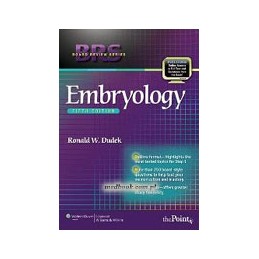- Reduced price

Order to parcel locker

easy pay


 Delivery policy
Delivery policy
Choose Paczkomat Inpost, Orlen Paczka, DHL, DPD or Poczta Polska. Click for more details
 Security policy
Security policy
Pay with a quick bank transfer, payment card or cash on delivery. Click for more details
 Return policy
Return policy
If you are a consumer, you can return the goods within 14 days. Click for more details
BRS Embryology, Fifth Edition is a succinct outline-format review for USMLE and course exams, with review questions at the end of each chapter and a comprehensive USMLE-style examination at the end of the book. The text outlines the important facts and concepts tested on the USMLE, within the context of human embryologic development. The book also includes radiographs, sonograms, computed tomography scans, and photographs of various congenital malformations. This edition has been updated and includes new, additional USMLE-style questions. Clinical images have been placed closer to the relevant text.
A companion website offers the fully searchable text and an interactive question bank.
Data sheet
Preface
1. Prefertilization Events
2. Week 1 of Human Development (Days 1-7)
3. Week 2 of Human Development (Days 8-14)
I. Further Development of the Embryoblast II. Further Development of the Trophoblast III. Development of Extraembryonic Mesoderm IV. Clinical Considerations Study Questions for Chapter 3 Answers and Explanations4. Embryonic Period (Weeks 3-8)
I. General Considerations II. Further Development of the Embryoblast III. Vasculogenesis IV. Hematopoiesis V. Clinical Considerations Study Questions for Chapter 4 Answers and Explanations5. Cardiovascular System
I. Formation of Heart Tube II. Primitive Heart Tube Dilatations III. The Aorticopulmonary (AP) Septum IV. The Atrial Septum V. The Atrioventricular (AV) Septum VI. The Interventricular (IV) Septum VII. The Conduction System of the Heart VIII. Coronary Arteries IX. Development of the Arterial System X. Development of the Venous System Study Questions for Chapter 5 Answers and Explanations6. Placenta and Amniotic Fluid
I. Formation of the Placenta II. Placental Components:: Decidua Basalis and Villous Chorion III. Placental Membrane IV. The Placenta as an Endocrine Organ V. The Umbilical Cord VI. Circulatory System of the Fetus VII. Amniotic Fluid VIII. Twinning IX. Clinical Considerations Study Questions for Chapter 6 Answers and Explanations7. Nervous System
I. Overview II. Development of the Neural Tube III. Neural Crest Cells IV. Placodes V. Vesicle Development of the Neural Tube VI. Histogenesis of the Neural Tube VII. Layers of the Early Neural Tube VIII. Development of the Spinal Cord IX. Development of the Myelencephalon X. Development of the Metencephalon XI. Development of the Mesencephalon XII. Development of the Diencephalon, Optic Structures, and Hypophysis XIII. Development of the Telencephalon XIV. Development of the Sympathetic Nervous System XV. Development of the Parasympathetic Nervous System XVI. Development of the Cranial Nerves XVII. Development of the Choroid Plexus XVIII. Congenital Malformations of the Central Nervous System Study Questions for Chapter 7 Answers and Explanations8. Ear
I. Overview II. The Internal Ear III. The Membranous and Bony Labyrinths IV. Middle Ear V. External Ear VI. Congenital Malformations of the Ear Study Questions for Chapter 8 Answers and Explanations9. Eye
I. Development of Optic Vesicle II. Development of Other Eye Structures III. Congenital Malformations of the Eye Study Questions for Chapter 9 Answers and Explanations10. Digestive System
I. Overview II. Derivatives of the Foregut III. Derivatives of the MidgutAbbreviated Table of Contents
